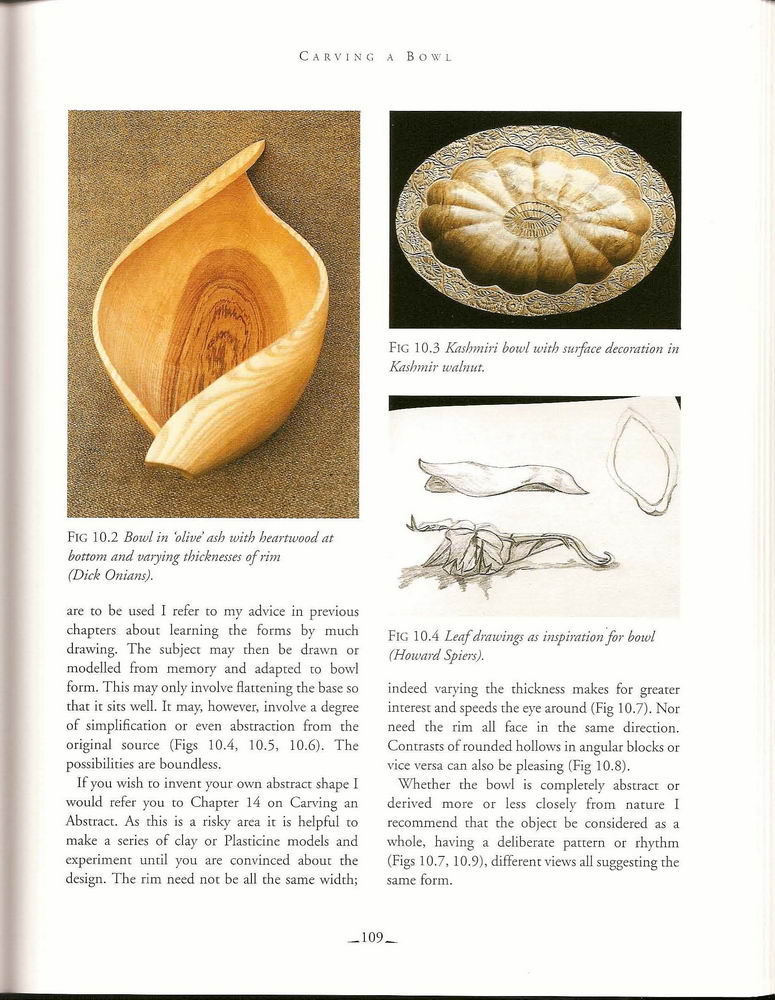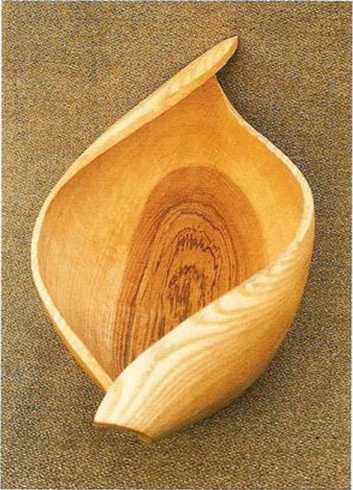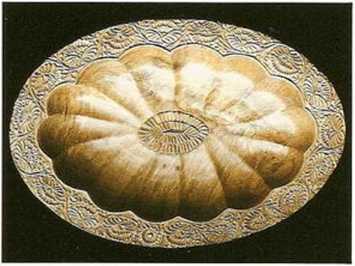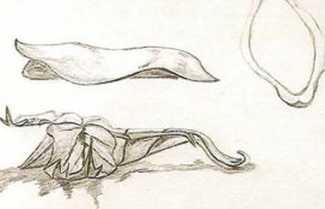essentÊrving±09

C A R V I N G A Bo W L

FlG 10.2 Boiul in olive ash with beartwood at bottom and oarying tbicknesses of rim (Dick Onians).
are to be used I refer to my advice in prcvious chapters about Icarning the forms by much drawing. The subject may thcn be drawn or modelled from memory and adaptcd to bowl form. This may only involve flattcning the base so that it sits well. It may. howcvcr, involve a degree of simplificarion or even abstraction from the original source (Figs 10.4, 10.5, 10.6). The possibilities are boundless.
If you wish to invent your own abstract shape I would refer you to Chaptcr 14 on Carving an Abstract. As this is a risky arca it is helpful to make a scrics of clay or Plasricinc models and cxperiment umil you are convinced about the design. The rim nced not be all the same width;

Fig 10.3 Kashmiri bowl with surface dccoration in Kasb/nir walnut.
/N

FlG 10.4 Leafdrawings as inspiration for bowl (Howard Spiers).
indeed varving the thickness makes for grcatcr interest and specds the eye around (Fig 10.7). Nor need the rim all face in the same direction. Contrasts of roundcd hollows in angular blocks or vice versa can also be plcasing (Fig 10.8).
Whethcr the bowl is completely abstract or derivcd morÄ™ or less closely from naturÄ™ I recommcnd that the object be considered as a whole, having a deliberate pattern or rhythm (Figs 10.7, 10.9), different views all suggesting the same form.
_109-_
Wyszukiwarka
Podobne podstrony:
essent?rving?13 C A R V I N C A Bo W L Fic; 10.14 Shaping the outside of a bowl with a No. 7, 8, 9,
168 STRESS ANALYSIS Stress distribution in side welded joints, by W.II- Weiskopf and M. Małe. Journa
Index Picots, crocheted 75 in the round 131 Sweaters, socks, gloves, and Pocket, inside of,
10. Contento IR., Basch C., Zybert P. 2003. Body image, weight, and food choices o
Modlin H.C.: A study of the MMPI in clinical practice with notes on the Cornell lndex. Amer. J. of P
al creatures 37 Abracadabra Give him some hair and a beard. Fili in his face with big eyebrows,
essent?rving?32 E SS EN T I A L W O O D C A R V I N G T ECHN’!QUES FlG 2.8 Stripy figurę in a mahoga
essent?rving?15 Fig 10.16 The smali beech bowl being held in a caruers chops with a bar across its m
Szaraniec Barbara, dr inż. Bibliografia Publikacji Pracowników AGH [4/10] [24] In
13013 rosebud ornaments 6 Rnd 5: SI st in next st, (sl st, ch 1, 10 sc) in first ch-8 sp, (skip ne
10 6 Logged in as bulba & © U m # a HOME GLOBALS SHARES PRINTERS STATUS VIE
więcej podobnych podstron